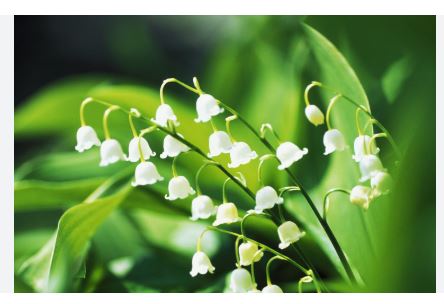
Lily of the Valley is scientifically known as Convallaria majalis. It belongs to the family Asparagaceae, previously classified under the Liliaceae family. Within the genus Convallaria, this species is notable for its bell-shaped flowers and spreading rhizomes.
Lily of the Valley has a rich history steeped in folklore and symbolism. It has been mentioned in literature and art since medieval times in Europe. It was associated with various myths, including being considered as the tears of the Virgin Mary in Christian lore, hence one of its common names, “Our Lady’s Tears.” Historically, it has been used for its fragrance in perfumery and for medicinal purposes, although its toxic nature limits its use. In the 19th and 20th centuries, it became a popular garden plant in Europe and North America due to its charming appearance and sweet scent.
Originally, Convallaria majalis is native to the cool temperate regions of the Northern Hemisphere, specifically in Europe and Asia. It grows in woodlands, preferring the semi-shade of deciduous forests. While it is not native to North America, there’s a variety, Convallaria majalis var. montana, which some sources suggest was native to North America, though this is a subject of debate as it might have been introduced through European settlement.
Lily of the Valley is a perennial plant, meaning it returns year after year, growing from its rhizomatous roots. Under ideal conditions, these plants can live for decades, spreading and forming dense colonies over time if not managed. They go dormant in winter, regrowing in the spring.
Lily of the Valley is hardy and can thrive in USDA Hardiness Zones 2 through 9. This broad range indicates its adaptability to various temperate climates, from very cold winters to milder ones. However, in the warmer end of this spectrum, particularly in zones 8 and 9, it might require more shade and moisture to prevent stress from heat.
How To Grow Lily of the Valley In Pots & Containers
Choosing the Right Pot
Opt for a wide, shallow pot to accommodate the spreading nature of Lily of the Valley’s rhizomes. A pot with a diameter of at least 12 inches will provide enough space for initial growth. Ensure the pot has good drainage holes to prevent waterlogging, which can lead to root rot.
Soil Selection
Lily of the Valley thrives in well-draining, rich, humus-filled soil with a slightly acidic to neutral pH (around 6.0 to 7.0). You can use a mix of potting soil, peat moss, and perlite or sand for improved drainage. Adding compost or well-rotted manure can enrich the soil with nutrients.
Planting Time
The best time to plant Lily of the Valley in pots is in the fall or early spring when the soil is cool but workable. This timing aligns with the plant’s natural growth cycle, allowing roots to establish before the active growing season.
Planting Pips
Lily of the Valley is typically planted using pips (small root sections with buds). Space these pips about 2-3 inches apart in the soil, with the buds facing upwards. Cover them with about an inch of soil, ensuring not to bury them too deeply.
Watering
After planting, water the soil thoroughly to settle it around the pips. Keep the soil consistently moist but not waterlogged. During growth, especially when flowering, Lily of the Valley requires more frequent watering. Reduce watering in winter as the plant goes dormant.
Light Conditions
In pots, Lily of the Valley prefers partial to full shade. Direct sunlight can be too intense, leading to scorched leaves. If indoors, place the pot near a north or east-facing window, or use a light shade cloth if outdoors in bright conditions.
Temperature
These plants are hardy but in pots, they can be more susceptible to temperature extremes. Protect pots from frost by moving them indoors or to a sheltered area during harsh winters. In summer, ensure they aren’t exposed to too much heat.
Fertilization
Use a balanced, slow-release fertilizer in early spring to encourage growth. A second light feeding after flowering can be beneficial but avoid over-fertilizing, which can lead to lush foliage at the expense of flowers.
Repotting
Every couple of years, you’ll need to repot your Lily of the Valley to prevent overcrowding. Gently lift the plant, divide the rhizomes, and replant in fresh soil. This also helps to manage the plant’s spread and rejuvenates the soil.
Pruning
After blooming, remove spent flowers to encourage potential reblooming or to maintain the plant’s appearance. Cut back any yellow or dead foliage in late fall or early winter to promote healthy growth in spring.
Pest and Disease Management
Keep an eye out for slugs and snails, which are attracted to the lush foliage. Aphids might also be an issue. Use organic pest control methods like neem oil or introduce beneficial insects. Good air circulation helps prevent fungal diseases.
Winter Care
If you’re in a colder climate, consider mulching the top of the soil with organic material like straw or leaves to insulate the roots. If very cold weather is expected, you might move the pot to a cool, unheated garage or shed, ensuring it doesn’t freeze solid but stays below 40°F to maintain dormancy.